British Steamer Mountaineer
Stranded December 25th, 1852
100 yards offshore of Kitty Hawk, NC.
Depth: 10 to 30 feet
Researched and written by: Marc Corbett
Kitty Hawk is a narrow strip of land, between the
Albemarle Sound and the Atlantic Ocean, on the Outer Banks of North
Carolina. The area has hosted quite it’s share of history most notably
the first powered airplane flight by the Wright Brothers in 1903. While
the first airplane took to the skies there was a wreck just off the
shore that had already been there quite some time.
People call it the “Winks Wreck” because it is close to the location of “Winks” grocery store, which is itself an old Kitty Hawk landmark. The wreck is located about 100 yards offshore, just south of Luke St. in about 20 feet of water. People have gone there for years to spear the Sheepshead, Tautog and Triggerfish that frequent the wreck. It isn’t a long swim, and lots of people free dive on the wreck during the summer.
I first dived on the wreck a few years ago; it’s what we
call a shore dive, a dive that can be done by simply walking into the
water off the beach with your dive gear, no boat required. Shore diving
is free but that does not mean it is easy; it takes some skill. Perhaps
the toughest part is just getting into the water. The soft sand seems to
suck out from beneath your feet as you try to make your way into the
water and after you make it off the beach you need to figure out how to
get through the surf. My suggestion is to emulate the surfers and duck
under the waves along the bottom. It is a lot easier than staying up on
the surface and being hit by the waves, as most of the force is in the
whitewater. With most diving you will learn that any items that aren’t
securely attached to your rig will be quickly lost. Nowhere is this more
true than in shore diving, any unsecured items are quickly lost and it
is quite a bit harder to find them than in calmer waters. While not
easy, I feel that a fairly simple shore dive, such as the “Winks”
wreck is well within the abilities of most good divers if they apply
themselves.
The wreck is located about 100 yards off the beach
directly in front of the oceanfront house just to the south of the Luke
St. beach access. The wreck is not far off the beach, it is closer to
shore than many of the other local shore wrecks, so be careful not to
swim out past the wreck. Once the wreck site is reached, what is visible
on the wreck will be determined largely by how uncovered it is. The
ocean bottom is a mass of underwater sand dunes that constantly shift
around due to wave action. On the Winks wreck site I have seen the wreck
completely uncovered all the way down to bottom of the hull, in a depth
of 20 feet of water. The wreck was in this condition in the summer of
2010, In the summer of 2011 the wreck was almost completely covered with
sand and the depth of the water only being about 6 or 7 feet. 2012 found
the wreck fairly uncovered in about 15 feet of water.
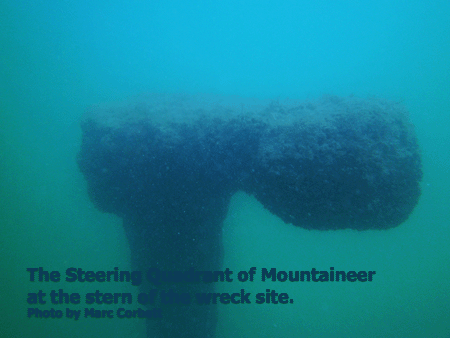 The wreck is roughly parallel with the beach with what I
believe to be the stern facing north. What would appear to be a steering
quadrant stands tall over the sand at the stern, it resembles a lower
case “r” with a large gear in the center. When visible, what remains
of the hull consists of wooden planks and beams fastened with copper or
bronze spikes. The copper spikes are quite shiny due to the polishing action of
the sand. There is actually quite a bit of sand polished bronze and copper on the
site. I might add that while these artifacts might make a nice dive
souvenir, one must keep in mind that it is illegal to remove artifacts
from any wrecks within 3 miles of the shore, so look, but don’t take
anything. Also at the north end of the wreck is a rather large iron box
lying with one of the bottom corners facing upwards. Heading southeast
from the steering quadrant are the remains of a boiler consisting of a
large amount of round pipes conglomerated in what may be a box
configuration.
The wreck is roughly parallel with the beach with what I
believe to be the stern facing north. What would appear to be a steering
quadrant stands tall over the sand at the stern, it resembles a lower
case “r” with a large gear in the center. When visible, what remains
of the hull consists of wooden planks and beams fastened with copper or
bronze spikes. The copper spikes are quite shiny due to the polishing action of
the sand. There is actually quite a bit of sand polished bronze and copper on the
site. I might add that while these artifacts might make a nice dive
souvenir, one must keep in mind that it is illegal to remove artifacts
from any wrecks within 3 miles of the shore, so look, but don’t take
anything. Also at the north end of the wreck is a rather large iron box
lying with one of the bottom corners facing upwards. Heading southeast
from the steering quadrant are the remains of a boiler consisting of a
large amount of round pipes conglomerated in what may be a box
configuration.
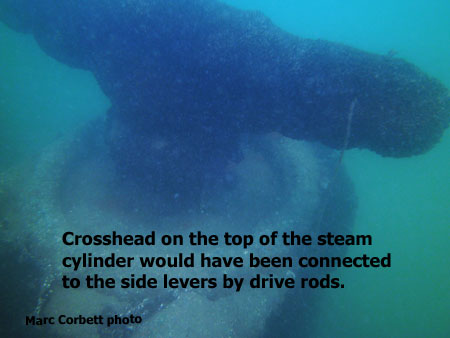 Encountered next are the two steam engines, the engines
themselves are quite unusual as far as steam engines found on North
Carolina dive sites go. Both engines are laid out the same way;
consisting of a rounded cylinder which resembles a giant oil drum,
complete with raised ribbing in the middle. The east cylinder has a
large crosshead at the top and the pieces are joined by a piston rod.
The west engine’s cylinder is missing the crosshead and part of the
piston rod still sticks up out of the top of the cylinder. In front of
the cylinders are large rectangular box shaped frameworks of heavy iron
with column like vertical supports with openings between them. Along
both sides of the framework are large cast iron arms joined at the
center to the bottom of the framework like teeter totters. The ends of
the arms are large and circular shaped. One end was attached to the
crosshead and the other end was attached to the paddle wheel machinery.
On the east side of the engines sits a square piece of metal sticking up
out of the sand. This is what remains of the paddle wheel assembly. Jim
Bunch supplied this picture from the 1980’s where more of the paddle
wheel assembly is visible. Jim also described how there used to be a
piece sticking up out of the water on the south side of the wreck. The
wreck site, as well as the steam engine, is not large, the distance
between the engines and steering quadrant is perhaps 20 or 30 feet.
Encountered next are the two steam engines, the engines
themselves are quite unusual as far as steam engines found on North
Carolina dive sites go. Both engines are laid out the same way;
consisting of a rounded cylinder which resembles a giant oil drum,
complete with raised ribbing in the middle. The east cylinder has a
large crosshead at the top and the pieces are joined by a piston rod.
The west engine’s cylinder is missing the crosshead and part of the
piston rod still sticks up out of the top of the cylinder. In front of
the cylinders are large rectangular box shaped frameworks of heavy iron
with column like vertical supports with openings between them. Along
both sides of the framework are large cast iron arms joined at the
center to the bottom of the framework like teeter totters. The ends of
the arms are large and circular shaped. One end was attached to the
crosshead and the other end was attached to the paddle wheel machinery.
On the east side of the engines sits a square piece of metal sticking up
out of the sand. This is what remains of the paddle wheel assembly. Jim
Bunch supplied this picture from the 1980’s where more of the paddle
wheel assembly is visible. Jim also described how there used to be a
piece sticking up out of the water on the south side of the wreck. The
wreck site, as well as the steam engine, is not large, the distance
between the engines and steering quadrant is perhaps 20 or 30 feet.
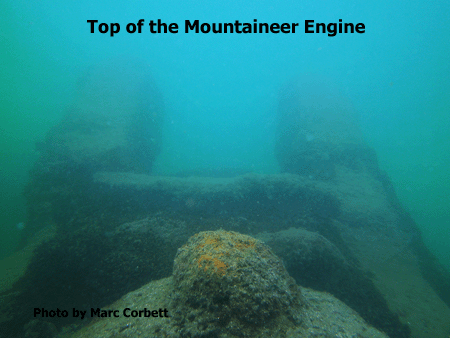
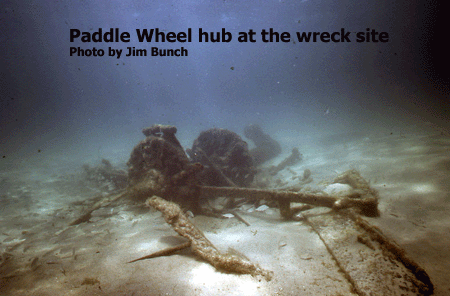
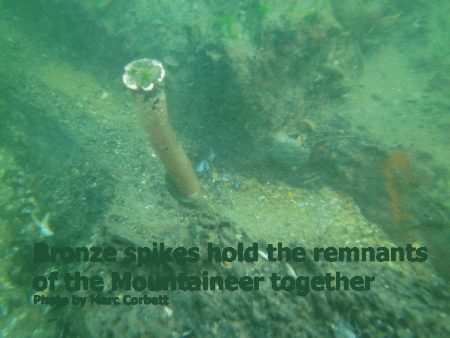
A fairly long search through trusted records of shipwrecks
in North Carolina revealed there to be three steamship wrecks reported
in the Kitty Hawk area: The Mountaineer, The Bladan McLaughlin, and the
Tzenny Chandris, so research into each of these ships was undertaken.
The Tzenny Chandris was a large Greek steel screw steamer
carrying a load of scrap iron. One may see her listed as “Jenny
Chandris” in some of the Registers. In any case she would appear to
have gone down offshore in 1937 and is far too big, far too modern to be
the Luke St. steamer, and most importantly not a wooden hulled vessel. The
Steamer Bladan McLaughlin went down in 1853 and would seem a more likely
match for the ship in the water off of Luke St. however, newspaper
reports of the day cite the salvage, removal, and sale of the ships
engines after the disaster. The
Mountaineer was listed as a British steamer which went down in Kitty
Hawk on Dec 25 1852. It
should be noted that she is the only early British steamer on the
various lists of shipwrecks reported to have gone down in the Kitty Hawk
area.
From the Newspaper “American Beacon” Norfolk Va. dated
Wed. December 29, 1852:
“Marine News”
“Disaster”
“The Br. Steamer Mountaineer, of and from Liverpool for
New Brunswick via Nassau, N. P. Stickney master went ashore on the 25th
last about 20 miles south Currituck Inlet and soon became a total wreck-
all aboard saved. She was an old steamer and had been lately purchased
by a lumber company in N.B., as a tug and stock boat, and was 196 tons,
English measurement. Her machinery was detached before sailing and the
hull brig rigged. She was 30 days from Nassau. It was the intention of
the Captain to put into Hampton Roads or New York to have her machinery
put in order and then to proceed under steam to his port of destination.
The crew arrived here yesterday - The captain and his wife will remain
on the beach until the wreck is sold.”
This article from the American Beacon was located in the holdings of the Library of Virginia, Richmond, VA.
The stated location of the wreck site isn’t far from the one listed in the article. While it is a few miles further south it is not uncommon for the actual distances reported in some of these older shipwreck reports to be a bit off. This is understandable considering that there were no mile markers at the time on the Outer Banks which was a pretty desolate stretch of coastline. The article lists the ships tonnage as 196 tons. Records would put the length of a 190 ton wooden British steamer of the era somewhere around 100 feet. This would not be a very large ship. The article states the Mountaineer was not in working order, this would certainly account for why the engines on the wreck were never salvaged. It was fairly common for the engines and other valuable parts of near shore shipwrecks to be salvaged, probably the most notable examples of this in the area being the wrecks of the USS Huron and the CSS Curlew.
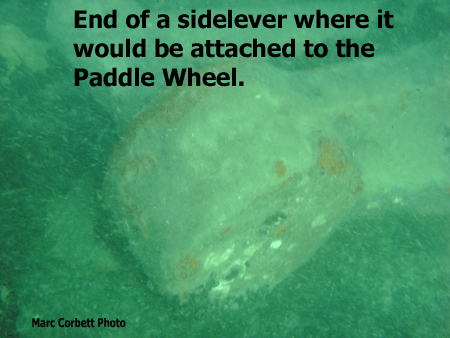 The article states that the Mountaineer was “of and from
Liverpool“, that would make her most likely to be of British
manufacture. It was also stated that she was old, which for a ship in
1852 would likely mean she was built in the 1820’s or 1830’s. When
one looks at the design of a typical early 19th century British paddle wheel steamer, the
similarity to the wreck off Luke St. is remarkable. The side lever
engine is almost unique to early British steamship designs. Early
examples were produced by the firms of both David and Robert Napier,
among others. It is considered the classic Clyde river steam engine, so
much so that there is a stunningly similar Robert Napier built engine on
display outside of the Denny Tank museum, part of the Scottish Maritime
museum. The side levers, powered by the simple single steam cylinder sat
low inside the ship; the design resulted in a lower center of gravity
than the overhead walking beam engines being built in the United States
and other nations at the time. The steam engines on the site are most
definitely of the single cylinder side lever variety. This would almost
certainly indicate British manufacture as few shipbuilders outside of
Britain ever produced this design.
The article states that the Mountaineer was “of and from
Liverpool“, that would make her most likely to be of British
manufacture. It was also stated that she was old, which for a ship in
1852 would likely mean she was built in the 1820’s or 1830’s. When
one looks at the design of a typical early 19th century British paddle wheel steamer, the
similarity to the wreck off Luke St. is remarkable. The side lever
engine is almost unique to early British steamship designs. Early
examples were produced by the firms of both David and Robert Napier,
among others. It is considered the classic Clyde river steam engine, so
much so that there is a stunningly similar Robert Napier built engine on
display outside of the Denny Tank museum, part of the Scottish Maritime
museum. The side levers, powered by the simple single steam cylinder sat
low inside the ship; the design resulted in a lower center of gravity
than the overhead walking beam engines being built in the United States
and other nations at the time. The steam engines on the site are most
definitely of the single cylinder side lever variety. This would almost
certainly indicate British manufacture as few shipbuilders outside of
Britain ever produced this design.
One thing I find problematic is the location of the boiler as well as the steering quadrant on the wreck. When compared with other British paddle wheel steamer designs, it would appear that the engine is on the wrong side of the boilers and steering quadrant. This however could be explained by the theory that the heavy engine would have stayed in place on the bottom whereas the parts of hull that contained the steering quadrant and boilers could have been more easily moved around on the wreck site by storm action, or collision over the years. The author has seen far larger pieces of shipwrecks, particularly boilers, which lay quite some distance from where they should be located due to storm action, dredging, or collisions. After some conversation with noted shipwreck diver and author Jim Bunch, it sounds quite possible that when he was diving the wreck in the 1970’s, the portion of the wreck with what appears to be the steering quadrant may have in fact been to the south side of the wreck site. It is also possible that the ship was in fact laid out in this manner; during the era when this ship was built the layout of the ships was not as standardized as during later eras.
There are records of a few early British steamers with the name Mountaineer. This includes one built by R. and A. Carswell, Greenock, on the Clyde River in Scotland launched in 1821 listed at 190 tons, 104 feet keel, engines built by David Napier. This does at a glance look like a promising lead, as it is a ship of similar size and tonnage. The dates given fit the time frame quite well, and the David Napier built engine is absolutely the kind of steam engine present on the wreck site. But other than some very short newspaper blurbs about the launch and a mention of the ship in transcripts of a court proceeding with a statement from Mr. David Napier, I have found very little else to link this particular ship to the newspaper report of the stranding in 1852.
There are a few arrivals and departures notices in newspapers to substantiate that Capt. Stickney was indeed sailing the seas in the steamer Mountaineer prior to the wreck in 1852
The Cork Examiner, August, 27, 1852 states this:
“August 26—Wind W. ARRIVED—Mountaineer Steamer, Stickney, St. John's, Liverpool”
Perhaps the most perplexing bit of information on this comes when one takes a look at the master of the ship in the 1852 article, Capt. Stickney. Canadian records report a ship called the Mountaineer from Liverpool arriving in Quebec on August 12 1842. The following is from Canadian emigration records from Quebec in 1842;
“A large portion of the emigrants arrived during the last week have suffered much from want of provisions and from sickness; the average length of their voyage over eight weeks.
The ship Mountaineer, with 505 passengers, was 68 days on her voyage, and her passengers suffered very much from sickness, 30 deaths having occurred previous to her arrival at quarantine, and two more during her detention there, from the effects of small-pox and typhus fever. Many of the passengers were so much reduced from want of food that the medical officer was under the necessity of retaining a number in hospital for a few days to enable them to recover their strength. The stock of provisions of a great many became exhausted after being out about five to six weeks, and they were under the necessity of purchasing food from the master at most exorbitant rates. This, as well as many other complaints made by the passengers, are now undergoing legal investigation, which when closed, will be duly reported. A large number of those people are proceeding to join their friends in the London and Western districts.
A.C. Buchanan, Chief Agent
Emigrant Department, Quebec
29 August, 1842”
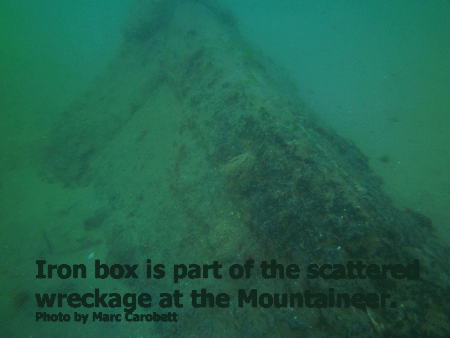 While none of
these records conclusively confirm or deny any connection, there is a
definite correlation of two ships of the same name, plying the same
routes with a Captain of the same name. This begs the question; is it
possible that this is in fact the same Capt. N.P. Stickney listed as
master of the steamer lost in 1852 at Kitty Hawk? If
so it might appear that Capt. Stickney may have been fond of the name
Mountaineer and could have possibly renamed another ship Mountaineer at
a later date. It is also
stated in the 1852 article that the ship wrecked on the beach was headed
to New Brunswick where it had been bought by a lumber company. The
1842 Lloyds register states the much heavier wooden sailing ship
Mountaineer was built in New Brunswick, thus another correlation.
While none of
these records conclusively confirm or deny any connection, there is a
definite correlation of two ships of the same name, plying the same
routes with a Captain of the same name. This begs the question; is it
possible that this is in fact the same Capt. N.P. Stickney listed as
master of the steamer lost in 1852 at Kitty Hawk? If
so it might appear that Capt. Stickney may have been fond of the name
Mountaineer and could have possibly renamed another ship Mountaineer at
a later date. It is also
stated in the 1852 article that the ship wrecked on the beach was headed
to New Brunswick where it had been bought by a lumber company. The
1842 Lloyds register states the much heavier wooden sailing ship
Mountaineer was built in New Brunswick, thus another correlation.
It is certainly plausible that this Capt. Stickney could have renamed the small steamer Mountaineer headed to New Brunswick in 1852. This theory is somewhat troubling to the shipwreck researcher, in that if the original name of the ship was not in fact Mountaineer, it could be quite difficult to actually determine what the earlier identity of the ship may have been. Records may exist in Great Britain, possibly in the National Archives at Kew, which could establish a better link to the ship’s origins.